JKBOSE 9th Class Science Solutions Chapter 10 Structure Of Atom
JKBOSE 9th Class Science Solutions Chapter 10 Structure Of Atom
JKBOSE 9th Class Science Solutions Chapter 10 Structure Of Atom
Jammu & Kashmir State Board JKBOSE 9th Class Science Solutions
J&K class 9th Science Structure Of Atom Textbook Questions and Answers
BASIS AND BASICS
◆ Fundamental particles of an atom are electron, proton and neutron.
◆ Electron is a negatively charged particle with 1.602 x 10-19 coulomb negative charge (- 1 unit) and mass 9.1089 × 10-31 kg (negligible mass). It is represented by the symbol ‘e’.
◆ Proton is a positively charged particle with 1.602 x 10-19 coulomb positive charge (+ 1 unit) and mass 1.672 x 10-27 kg, it is represented by the symbol ‘p’. Neutron is a neutral particle with no charge and mass equal to 1.678 × 10-27 kg, It is represented by the symbol ‘n’.
◆ Electrons were discovered by J.J. Thomson.
◆ Protons were discovered by J.J. Thomson.
◆ Neutrons were discovered by James Chadwick.
◆ An atom consists of two parts :
(a) nucleus (b) extra nuclear part.
◆ Nucleus is the small, positively charged and heavy central portion in an atom which contains in it protons and neutrons.
◆ Nucleons. The neutrons and protons present in the nucleus of an atom are collectively known as nucleons.
◆ Extranuclear part contains electrons.
◆ Cathode rays consist of negatively charged particles called electrons.
◆ Anode rays consist of positively charged particles. These are also called canal rays.
◆ Atomic number of an element represents the number of protons in an atom. It is denoted by the symbol Z.
◆ Shells of an atom are designated as K, L, M, N, etc. These are also called energy levels.
◆ Elements are specified in terms of their atomic numbers. (or nucleons)
◆ Valence shell of an atom represents the outermost shell where electrons are present and the electrons are called valence electrons.
◆ Mass number of an element is the sum of the number of protons and neutrons present in the nucleus of the atom. It is denoted by A.
◆ Valence shell of an atom represents the outermost shell where electrons are present and the electrons are called valence electrons.
◆ Valency. It is the combining capacity of an atom of the element. It is equal to number of electrons in the valence shell (no. of electrons is less than 4) or 8 Number of both electrons in the valence shell (Number of electrons more than 4).
◆ Isotopes are the atoms of the same element having same atomic number but different mass numbers.
◆ Isobars are the atoms of the different elements having same mass number but different atomic numbers.
◆ Thomson’s model, Rutherford’s Nuclear Model and Bohr’s model are the different models for an atom.
◆ Rutherford’s model of an atom lead to the discovery of the nucleus.
◆ Bohr’s Model of an atom assumes quantisation of energy and quantisation of angular momentum of an electron.
IMPORTANT TERMS/FACTS TO MEMORIES
Fundamental particles of an atom : Electrons, Protons and Neutrons.
⇒ Mass of electron = 9.1089 × 10-31 kg
⇒ Mass of proton = 1.672 × 10-27 kg
⇒ Mass of neutron = 1.675 × 10-27 kg
⇒ Charge of electron (e) = -1.602 × 10-19 C
⇒ Charger on proton (p) = + 1.602 × 10-19 C
⇒ e/m for electron = -1.76 × 108 C/g
⇒ e/m for proton = +9.58 × 104 C/g
⇒ Mass Number → A
X ← Symbol of the element
Atomic number → Z
⇒ No. of protons is an atom = Z
⇒ No. of electrons in an atom = Z
⇒ Mass no. of an element = A = No. of neutrons + of Protons.
⇒ No. of neutrons = Mass no. (A) – Atomic no. (Z)
⇒ Maximum numbers of electrons in a shell = 2n2where n= 1,2,…..
⇒ Maximum numbers of electrons in the valence shell = 8.
TEXTBOOK QUESTIONS (SOLVED)
Q. 1. What are canal rays ?
Ans.— A beam of rays or stream of particles which travel in a direction away from anode, towards cathode, when any gas taken in a discharge tube is subjected to the action of high voltage under low pressure are called canal rays.
Q. 2. If an atom contains one electron and one proton, will it carry any charge or not ?
Ans.— No, it will not carry any charge.
Q. 3. On the basis of Thomson’s model of an atom explain how the atom is neutral as a whole.
Ans.— Thomson’s model of atom.
1. According to Thomson, an atom may be regarded as a uniform sphere of positive electricity (protons) in which negatively charged electrons are embedded like the seeds in a watermelon.

2. The total positive charge is equal to the total negative charge on all the electrons so that atoms on the whole is electrically neutral.
Q. 4. On the basis of Rutherford’s model of an atom which sub-atomic particle is present in the molecule of an atom ?
Ans.— Proton.
Q. 5. Draw a sketch of Bohr’s model of an atom with three shells.
Ans.—
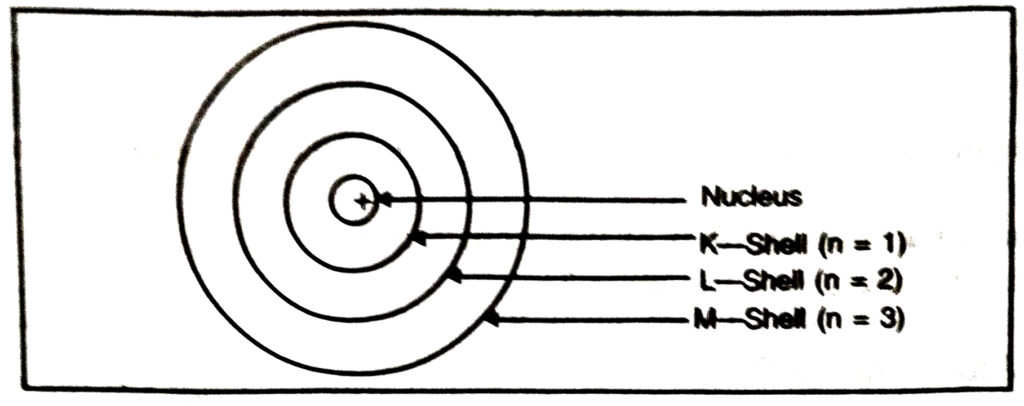
Q. 6. What do you think would be the observation if the a-particle scattering experiment is carried out using a foil of metal other than gold ?
Ans.— Almost all the a-particles will pass undeflected and hardly any a-particle is deflected.
Q. 7. Name the three sub-atomic particles of an atom.
Ans.— These are :
(a) Electron
(b) Proton and
(c) Neutron.
Q. 8. Helium atom has an atomic mass of 4 u and two protons in its nucleus. How many neutrons does it have ?
Ans.— Atomic mass of Helium = 4 u
No. of protons = 2
No. of neutrons = 4 – 2 = 2
Q. 9. Write the distribution of electrons in carbon and sodium atoms.
Ans.—

Q. 10. If K and L shell of an atom are full then what would be the total number of electrons in it ?
Ans.— No. of electrons in K-shell = 2
No. of electrons in L-shell = 8
Total no. of electrons = 2 + 8 = 10
Q. 11. How will you find the valency of chlorine, sulphur and magnesium ?
Ans.— Chlorine has the electronic configuration = 2, 8, 7
∴ Valency of chlorine = 8 -7 = 1
Sulphur has the electronic configuration = 2, 8, 6
∴ Valency of sulphur = 8 – 6 = 2
Magnesium has the electronic configuration = 2, 8, 2
∴ Valency of magnesium = 2
Q. 12. If number of electrons in an atom are 8 and number of protons are also 8, then :
(i) What is the atomic number of the atom ? and
(ii) What is the charge on the atom ?
Ans.— (i) No. of protons = 8
∴ Atomic no. of the element = 8
(ii) Zero.
Q. 13. With the help of table 4.1 (given in NCERT BOOK) find out the mass number of oxygen and sulphur atom.
Ans.— P n
Mass number of oxygen = 8 + 8 = 16
Mass number of sulphur = 16 + 16 = 32
Q. 14. For the symbol H, D and T tabulate three fundamental particles found in each of them.
Ans.—
| Symbol of element | Atomic number | Mass No. | No. of electrons | No. of Protons | No. of neutrons |
| H | 1 | 1 | 1 | 1 | 0 |
| D | 1 | 2 | 1 | 1 | 1 |
| T | 1 | 3 | 1 | 1 | 2 |
Q. 15. Write the electronic configuration of any one pair of isotopes and isobars.
Ans.— Pair of Isotopes : 35/17Cl and 35/17Cl
Atomic number of Cl = 17
Electronic configuration of these isotopes = K, L, M / 2,8, 7
Pair of Isobars : 40/18 Ar and 40/20 Ca
Atomic number of Ar = 18
Electronic Configuration of 40/18 Ar = K, L, M / 2, 8, 8
Atomic number of Ca = 20
Electronic Configuration of 40/20 Ca = K, L, M, N / 2, 8, 8, 2
TEXTBOOK EXERCISES (SOLVED)
Q.1. Compare the properties of electron, proton and neutron.
Ans.—
| Particle | Charge(e) | Mass (m) | Charge / Mass (e/m) |
| Electron | – 1.6022 × 10-19 C | 9.109 × 1028 g | – 1.76 × 108 |
| Proton | + 1.6022 × 10-19 C | 1.672 × 1024 g | + 9.58 × 104 |
| Neutron | Zero | 1.675 × 10-24 g | Zero |
Q. 2. What are the limitations of J.J. Thomson model of the atom ?
Ans.— Limitations of J.J. Thomson model of the atom :
1. It could not explain stability of the atom.
2. It could not explain hydrogen spectrum.
Q. 3. What are the limitations of Rutherford’s model of atom ?
Ans.— Limitations of Rutherford’s model of atom :
1. It can’t explain stability of the atom.
2. It can’t explain hydrogen spectrum.
Q. 4. Describe Bohr’s model of atom.
Ans.— The main points of Bohr’s model of atom are :
1. An atom has three types of particles called fundamental particles. These are electrons, protons and neutrons.
2. The protons and neutrons are present in the nucleus, present in the centre. The electrons are present around the nucleus and at very large distances from it. There is a large vacant space between the nucleus and the electrons.
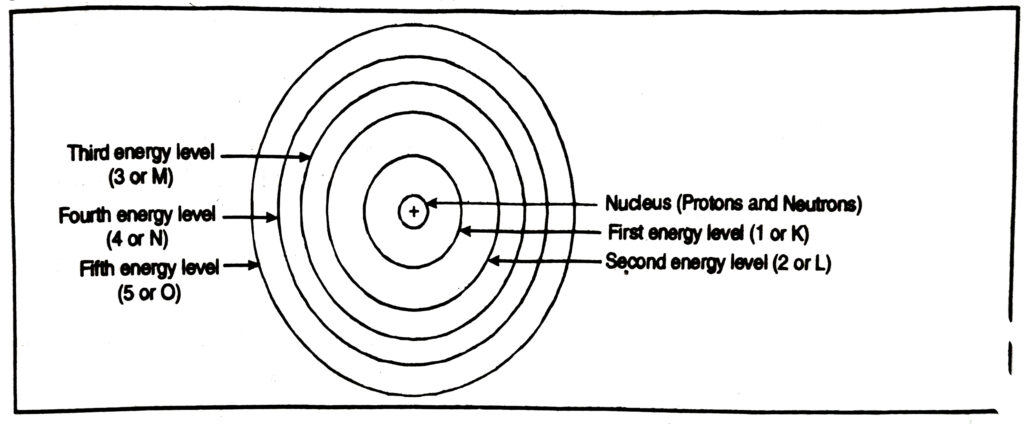
3. An atom is electrically neutral as the number of protons is equal to the number of electrons.
4. The electrons are revolving around the nucleus in fixed circular paths which are called energy levels or energy shells or orbits. The energy levels or energy shells can be counted in two ways 1, 2, 3, 4, 5, 6 or as K, L, M, N, O, P. The counting starts from the centre outwards,
5. The various energy levels are arranged in order of increasing energy. The order of energy is 1 < 2 <3 <4 <5 or K<L<M<N<O or <L<M<N<0
6. The energy of an electron in an atom is quantised.
7. There is no change in the energy of the electrons as long as they keep on revolving in the same energy level.
8. The angular momentum of an electron in an atom is quantised.
9. The change in energy can take place only when the electron jumps from one energy level to the other. If the electron gains energy from outside, it jumps from lower energy to the higher energy level. If the electron jumps from higher energy level to the lower energy level, it loses energy.
Q. 5. Compare all the proposed models of an atom given in the chapter 3 of the text.
Ans.— Give Thomsons’s model, Rutherford’s model and Bohr’s model of atom.
A. Thomson’s model of atom.
1. According to Thomson, an atom may be regarded as a uniform sphere of positive electricity (protons) in which negatively charged electrons are embedded like the seeds in a watermelon.

2. The total positive charge is equal to the total negative charge on all the electrons so that atoms on the whole is electrically neutral.
B. Rutherford’s nuclear model of an atom. The main features of Rutherford’s nuclear model of an atom are :
1. Atom has a dense, heavy, positively charged central part called nucleus.
2. The electrons are present at very large distances from the nucleus.
3. The total positive charge on the nucleus is equal to the total -ve charge on all the electrons so that atom on the whole is electrically neutral.
4. The electrons are revolving around the nucleus so that attractive force of the nucleus is balanced by the centrifugal force (just like planets revolve around the sun). It is different from Thomson’s model, because in Thomson’s model in an atom, the total mass, positive charge and electrons are uniformly distributed.
C. Bohr’s model of an atom. Described in Question No. 4 given above.
Q. 6. Summarize the rules for writing of distribution of electrons in various shells for the first eighteen elements.
Ans.— The various rules for writing the electronic configuration of first elements are :
1. The energy levels or energy shells are filled in order of increasing energies. The electrons first enter the K shell (n = 1) which is closest to the nucleus. This is followed by L shell (n = 2), M shell (n = 3) and so on. Here ‘n’ represents the number of the shell.
2. The maximum number of electrons in any shell is given as 2n² (n = No. of the shell).
3. The outermost energy shell cannot have more than 8 electrons. The next inner shell called penultimate shell cannot have more than 18 electrons.
4. It is not necessary that an energy level or shell is fully filled before the filling in the next starts. In fact filling of electrons in a new shell starts when any shell contains 8 electrons.
Q. 7. Define valency by taking examples of silicon and oxygen.
Ans.— Valency. It is the combining capacity of an atom of the element and is numerically equal to the number of electrons present in the valence shell of an atom (if the no. of electrons is 1 to 4) or eight minus the number of electrons present in the valence shell of an atom (if the no. of electrons is more than 4).
e.g. Silicon (14Si) has electronic configuration = K, L, M / 2, 8, 4
∴ its valency = 4 (No. of electrons in its valence shell)
Oxygen (16/8 O) has electronic configuration = 2,6
∴ its valency=8 – 6 = 2 (8 – No. of electrons in the valence shell)
Q. 8. Explain with examples.
(i) Atomic number (ii) Mass number (iii) Isotopes (iv) Isobars. Give any two uses of isotopes.
Ans.— (i) Atomic number. It is the number of protons present in the nucleus of an atom of an element.
(ii) Mass number. It is the sum of total number of protons and neutrons present in the nucleus of an atom.
(iii) Isotopes. These are the atoms of the same element having same atomic number but different mass numbers.
(iv) Isobars. These are the atoms of different elements having same mass number but different atomic numbers.
Uses of isotopes tera
1. 235/92 U isotope of uranium is used as a fuel in nuclear reaction.
2. 60/27 Co isotope of cobalt is used in the treatment of cancer.
3. 131/53 isotope of iodine is used in the treatment of goitre.
Q. 9. Na+ has completely filled K and L shells. Explain.
Ans.—Na has atomic number = 11
∴ Na atom has electrons =
Na+ ion has electrons = 11 – 1 = 10
The electronic configuration of Na+ = 2, 8 / K, L
∴ In Na+, K and L-shells are completely filled.
Q. 10. If bromine atom is in the form of say two isotopes 79/35 Br (49.7%) and 81/35 Br (50.3%), then calculate the average mass of bromine atom.
Ans.— The two isotopes of bromine are 79/35 Br and 81/35 Br
(49.7%) (50.3%)
Average atomic mass of bromine atom = 79 × 49.7 + 81 × 50.3 / 100
= 3926.3 + 4074.3 / 100
= 80.006 u
Q. 11. The average atomic mass of a sample of an element X is 16.2 u, what are the percentages of isotopes 16/8X and 18/8 X in the sample ?
Ans.—
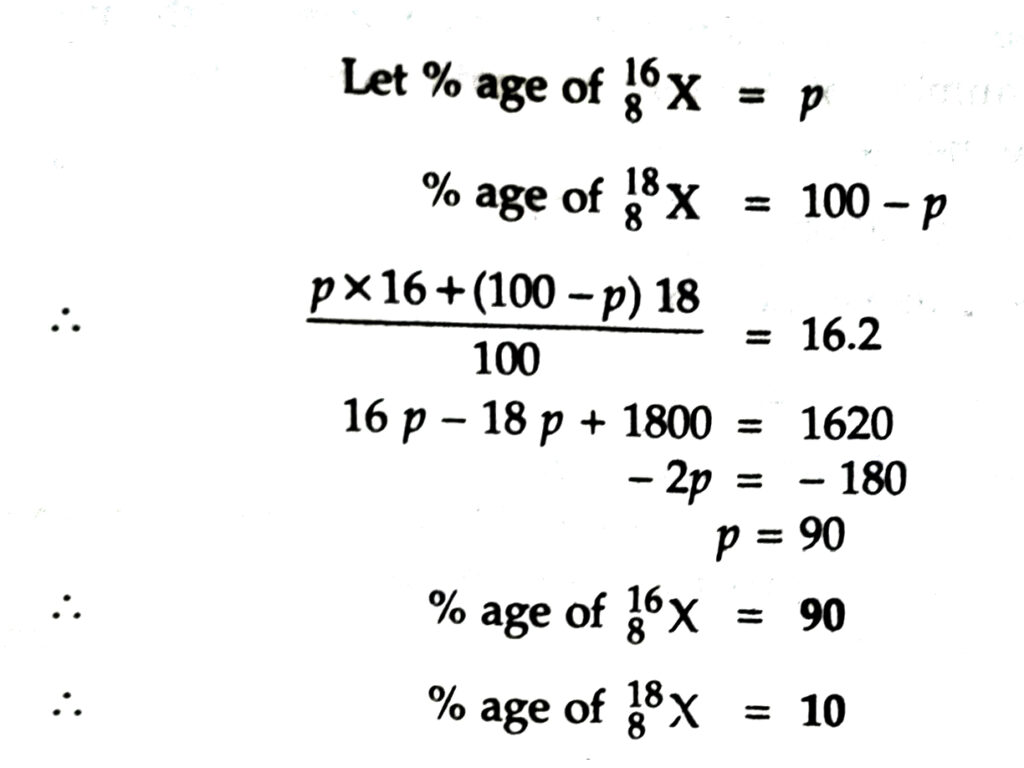
Q. 12. If Z= 3, what would be the valency of the element? Also, name the element.
Ans.— Z = 3
∴ Atomic no. of element = 3
∴ No. of electrons in one atom of the element = 3
Its electronic configuration = K, L / 2, 1
Hence its valency = 1 (No. of electrons in the valence shell.)
The name of the element = Lithium.
Q. 13. Composition of the nuclei of two atomic species X and Y are given as under :
X Y
Protons 6 6
Neutrons 6 8
Give the mass numbers of X and Y. What is the relation between the two species ?
Ans.— Mass no. of X = 6 + 6 = 12
Mass no. of Y = 6 + 8 = 14
The two species are isotopes because they have same atomic number but different mass numbers.
Q. 14. For the following statements write T for True and F for False.
(a) J.J. Thomson proposed that the nucleus of an atom contains only nucleons.
(b) A neutron is formed by an electron and a proton combining together. Therefore, it is neutral.
(c) The mass of an electron is about 1/2000 times that of proton.
(d) Isotope of iodine is used for making tincture iodine, which is used as a medicine.
Ans.— (a) F (b) F (c) T (d) F.
Put tick (√) against correct choice and cross (x) against wrong choice in questions 15, 16 and 17.
Q. 15. Rutherford’s alpha-particle scattering experiment was responsible for the discovery of:
(a) Atomic Nucleus
(b) Electron
(c) Proton
(d) Neutron
Ans.— (a). Atomic Nucleus (✓)
(b) Electron (x)
(c) Proton (x)
(d) Neutron (x)
Q. 16. Isotopes of an element have :
(a) the same physical properties
(b) different chemical properties
(c) different number of neutrons.
(d) different atomic numbers.
Ans.—(a) the same physical properties. (✓)
(b) different chemical properties (x)
(c) different number of neutrons. (x)
(d) different atomic numbers (x)
Q. 17. Number of valence electrons in C1– ion are:
(a) 16
(b) 8
(c) 17
(d) 18.
Ans.— (a) 16 (x) (b) 8 (√) (c) 17 (x) (d) 18 (×).
Q. 18. Which one of the following is a correct electronic configuration of sodium ?
(a) 2,8
(b) 8,2,1
(c) 2, 1, 8
(d) 2, 8, 1.
Ans.— (d).
Q. 19. Complete the following table :
| Atomic Number | Mass Number | Number of Neutrons | No of Protons | Number of Electrons | Name of the Atomic Species |
| 9 | – | 10 | – | – | – |
| 16 | 32 | – | – | – | Sulphur |
| – | 24 | – | 12 | – | – |
| – | 2 | – | 1 | – | – |
| – | 1 | 0 | 1 | 0 | – |
Ans.—
| Atomic Number | Mass Number | Number of Neutrons | Number of Protons | Number of Electrons | Name of the Atomic Species |
| 9 | 19 | 10 | 9 | 9 | Fluorine |
| 16 | 32 | 16 | 16 | 16 | Sulphur |
| 12 | 24 | 12 | 12 | 12 | Magnesium |
| 1 | 2 | 1 | 1 | 1 | Deuterium |
| 1 | 1 | 0 | 1 | 0 | Hydrogen |
ADDITIONAL IMPORTANT QUESTIONS
LONG ANSWER TYPE QUESTIONS
Q. 1. Who discovered the presence of electrons in an atom? Discuss an experiment connected with it.
Ans.— J.J. Thomson found the presence of electrons in the cathode rays. The cathode rays were discovered with the help of discharge tube experiment as given below :
Discharge tube experiment. The discharge tube consists of a hard glass tube and has two metal plates sealed at its two ends. These plates are connected to a high voltage of battery or generator which can produce a voltage of 5000 to 10000 volts. The discharge tube is also connected to the vacuum pump which can decrease the pressure pressure to any value.
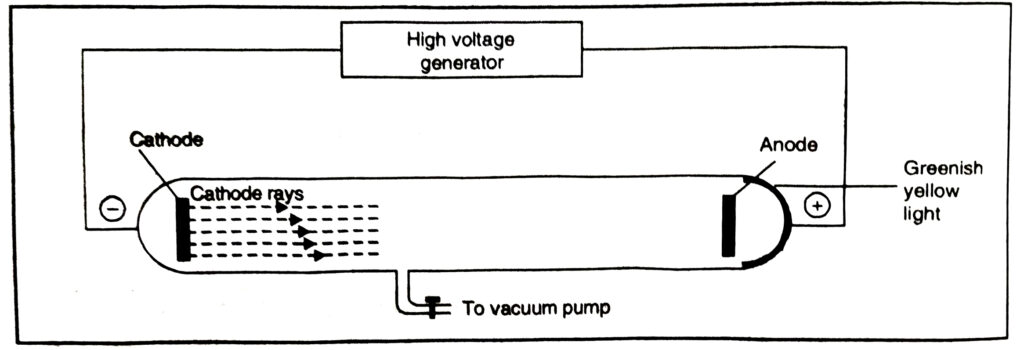
(i) When an electric discharge was passed through the discharge tube under normal atmospheric pressure, no electricity could pass because the gas inside the tube is poor conductor of electricity.
(ii) When the pressure inside the tube was reduced to 1 mm of Hg by pumping out the gas with the help of the vacuum pump, the gas inside the tube began to glow and conduct electricity.
(iii) Upon reducing the pressure further to 0.001 mm of mercury, the glow became weak but the end opposite to cathode began to glow with greenish yellow light.
It was found later on that at very low pressure (0.001 mm), some invisible rays were emitted from the cathode and upon striking the anode, they produced greenish light which is also called fluorescence. Since these rays were produced from the cathode, these are called cathode rays.
Q. 2. What are anode rays? How will you account for the origin of the anode rays ?
Ans.— The beam of rays or stream of particles which travel in a direction away from anode towards cathode when any gas is subjected to the action of high voltage at low pressure are called anode rays.
Goldstein used a perforated plate of metal having small holes in it as the cathode. When the pressure inside the discharge tube was reduced to 0.001 mm of Hg as in case of cathode rays, two types of rays were noticed in the discharge tube, one moving towards the anode and were called anode rays and the other moving towards the cathode and then passing through the holes. Since these rays were attracted towards the cathode, they were expected to have positive charges. They were called positive rays. As these rays moved away from the anode, they were also called anode rays.
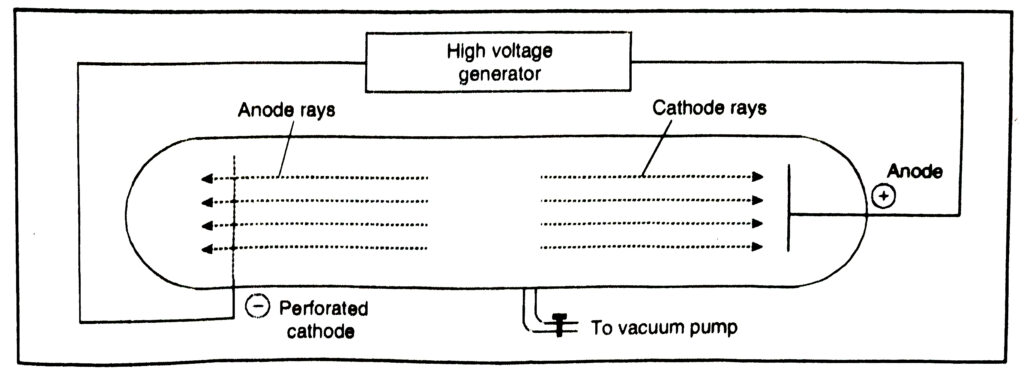
Q. 3. Discuss the discovery of neutrons.
Ans.— After the discovery of proton (one unit mass) and electron (negligible mass), it was thought that the mass of the atom is because of protons only. This is true in case of hydrogen atom. Its mass is 1 a.m.u. which is the same as the mass of the proton. But the mass of the next element helium (He) was found to be 4 a.m.u but it has only two protons. The two protons account for 2 a.m.u. mass. In order to explain the rest of the mass, it was believed that some neutral particles must be present in atom which have definite mass and no charge. These neutral particles were discovered by Chadwick in 1932 and were called neutrons. He obtained neutrons by bombarding light elements beryllium, boron with fast moving a-particles
9/4 Be + a → 12/6 C + 1/0 n (neutron)
Q. 4. Describe the Rutherford’s experiment to establish the position of electrons and protons in an atom.
Ans.— Rutherford’s a-ray scattering experiment. In 1911, Rutherford performed an experiment to establish the position of electrons and protons in an atom. This is called alpha ray scattering experiment. In this experiment, Rutherford obtained a thin stream of fast moving alpha (a) particles from radioactive source (P0) and was allowed to strike against a thin foil of heavy metal like gold. Alpha particles are also called helium nuclei (He2+ with + 2 unit charge and 4 a.m.u. mass). As a result of the experiment, he made the following observations :
1. Most of the a-particles passed through the gold foil without any deflection from their original path.
2. Some of the a-particles got deflected by small angles from their original path.
3. A few a-particles (approximately 1 out of 10,000) were deflected to a large extent. In some cases, the a-particles came back in the same direction after striking the gold foil.
Explanation for the observations :
We know that the gold foil is made up of atoms of gold which are placed side by side. Since most of the a-particles passed through these atoms undeflected they did not come across any obstruction in their path, this shows that most of the space in the atom is light or hollow. The electrons with negligible mass were supposed to be present in this portion called extra nuclear portion. The a-particles were deflected from their path and a very few came back in the same direction. This shows that they must have met with some obstruction in their path and it must be.
(i) Heavy because a-particles are high speed particles and can remove light obstruction from their path.
(ii) Small because only small number of a-particles got deflected.
(iii) Positively charged because some a-particles were repelled by this obstruction.
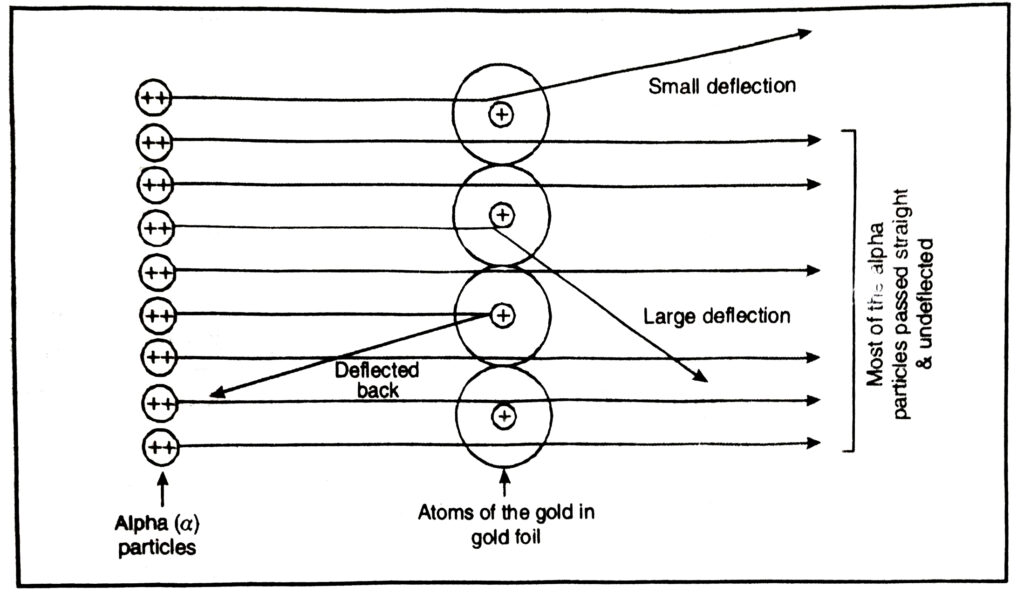
This small, heavy and positively charged portion inside an atom was called nucleus. The protons with mass and positive charge were supposed to present in the nucleus. Later on, neutrons were also found to be present in the nucleus of the atom.
Q. 5. Discuss in brief Rutherford’s Model of atom.
Ans.— The main points of Rutherford’s model atom are listed as follows :
(i) An atom has two parts. These are nucleus and extra nuclear portion. Extra nuclear portion
(ii) The nucleus contains protons while electrons are present in the extra nuclear portion.
(iii) Most of the mass of the atom is due to the nucleus because electrons have negligible mass.
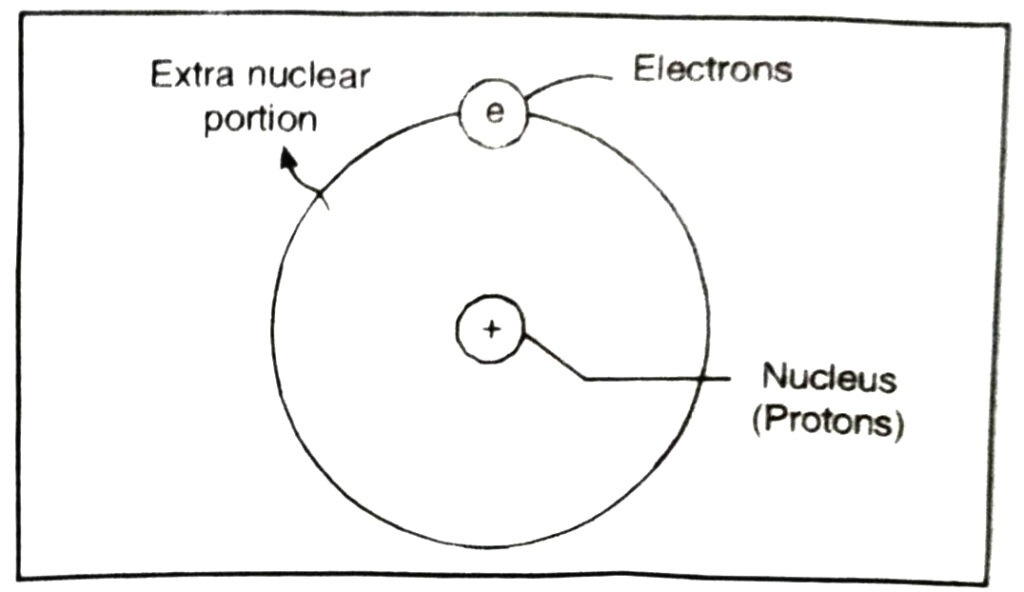
(iv) The volume occupied by the nucleus is very small as compared to the volume occupied by extra nuclear portion.
(v) The electrons in the extra nuclear portion are not stationary. These are revolving around the nucleus. The electrons are called planetary electrons because they can be compared to various planets which revolve around the sun. The nucleus may be compared with the sun.
Q. 6. Discuss the arrangement of the electrons in the different energy levels.
Or
Describe Bohr-Bury scheme for the distribution of electrons in the various orbits or energy levels of an atom.
Ans.— The distribution of electrons in the energy levels is given with the help of Bohr Bury scheme. It is given as follows :
1. The energy levels or energy shells are filled in order of increasing energies. The electrons first enter the K shell (n = 1) which is closest to the nucleus. This is followed by L shell (n=2), M shell (n = 3) and so on. Here ‘n’ represents the number of the shell.
2. The maximum number of electrons in any shell is given as 2n² (n = number of the shell). The distribution in the first four energy shells is given in the table given below :
3. The outermost energy shell cannot have more than 8 electrons. The next inner shell called penultimate shell, cannot have more than 18 electrons.
4. It is not necessary that an energy level or shell is fully filled before the filling in the next starts. In fact filling of electrons in a new shell starts when any shell contains electrons.
Distribution of electrons in first four energy shells according to 2n² rule.
| Symbol of shell | Number of shell (Value of n) | Maximum number of electrons (2n²) |
| K | 1 | 2 × (1)² = 2 |
| L | 2 | 2 × (2)² = 8 |
| M | 3 | 2 × (3)² = 18 |
| N | 4 | 2 × (4)² = 32 |
Q. 7. Give the nature of the elements (metal, non – metal, noble gas), their physical states and valencies (having atomic number 1 to 20) Also give their mass numbers.
Ans.—

Q. 8. Give the electronic distribution in the first twenty elements on the basis of Bohr-Bury scheme.
Ans.— On the basis of Bohr-Bury scheme, the distribution of electrons in first twenty elements (Z 1 to Z = 20) is given below :
Table : Electronic distribution in atoms of first 20 elements

Special cases of Potassium and Calcium
In case of Potassium (Z = 19), the M shell has only 8 electrons and not 18. Actually, when the M shell gets 8 electrons, the filling of electrons starts in the next shell which is N-shell. When the N-shell gets 2 electrons, the electron are again filled in the M shell. Thus, electronic distribution in potassium (Z = 19) is
K L M N
2 8 8 1 (M shell has 8 electrons and N shell has 1 electron).
Similarly, the electronic distribution in calcium (Z = 20) is :
K L M N
2 8 8 2 (M shell has 8 electrons and N shell has 2 electrons).

SHORT ANSWER TYPE QUESTIONS
Q. 1. Give two conditions under which cathode rays are produced.
Ans.— Cathode rays are produced when a gas is subjected to the action of
(i) High voltage of the order of 5000-10000 V and
(ii) Under a low pressure of the order of 10-3 atm of Hg.
Q. 2. What is the information conveyed by the following observations :
(i) Atom is electrically neutral.
(ii) Mass of the atom is due to the nucleus.
Ans.— (i) If an atom is electrically neutral, this means that it will have equal number of protons and electrons. Both protons and electrons have 1 unit charge but with opposite sign.
(ii) This means that nucleus contains in it both protons and neutrons which have mass.
Q. 3. What information is conveyed by the statement that the mass number of magnesium is 24 and the atomic number is 12 ?
Ans.— The atomic number (12) of magnesium indicates that its atom has 12 protons in the nucleus and an equal number of electrons in the extra nuclear portion. The mass number (24) points out that there are also 12 neutrons (24 – 12 = 12) present in the nucleus alongwith protons.
Q. 4. The electronic configuration of P (Z = 15) is 2, 8, 5. Why is the valency of phosphorus 3 and not 5 ?
Ans.— The electronic configuration of phosphorus (P) shows that it has 5 valence electrons. Its valency is expected to be 5. But it is not possible for the atom to lose 5 electrons present in the valence shell because the energy required to remove these electrons will be very high. Therefore, phosphorus atom has valency equal to 3 (8- No. of valence electrons).
Q. 5. Why did Rutherford select a gold foil in his a-ray scattering experiment ?
Ans.— This is because gold is highly malleable and can be beaten into very fine sheets or foils.
Q. 6. What are isobars ? Give examples.
Ans.— The atom of different elements having same mass numbers but different atomic numbers are called isobars.
e.g. (i) 40/18 Ar and 40/19 K (ii) 86/36 Kr and 86/38Sr.
Q. 7. Helium has only 2 electrons in the K-shell. But it is called an inert gas element. Why ?
Ans.— He atom has only one shell (K-shell) which can have a maximum of 2 electrons only. It cannot have more than 2 electrons. As a result, the combining capacity of He is zero. Therefore, its valency is also zero.
Q. 8. Give the important properties or characteristics of isotopes.
Ans.— 1. The isotopes of an element have same atomic number (Z) i.e. the same number of electrons and same number of protons. Hence, they have identical chemical properties.
2. Isotopes of an element have same number of valence electrons and hence same valency.
3. Isotopes of an element have different mass numbers (or different number of neturons) and hence they have different physical properties such as mass, density, melting point, boiling point etc.
Q. 9. What are isotopes ? Give two uses of isotopes. Name the isotopes of hydrogen. Give their structures.
Ans.— Isotopes. The atoms of the same element having the same atomic number but different mass numbers are called isotopes.
Use of isotopes
1. Isotopes of hydrogen, oxygen, carbon are used to study the mechanisms of organic reactions.
2. Some radioactive isotopes are used for the treatment of cancer and other diseases.
The isotopes of hydrogen are :
(a) Protium, 1/1 H (b) Deuterium, 2/1 H (c) Tritium, 3/1H
The atomic structures of isotopes of hydrogen are

| 1/1 H or Protium | 2/1 H or Deuterium | 3/1 H or Tritium |
| Atomic number = 1 | Atomic number = 1 | Atomic number = 1 |
| Mass number = 1 | Mass number = 2 | Mass number = 3 |
| No. of protons = 1 | No. of protons = 1 | No. of protons = 1 |
| No. of electrons = 1 | No. of electrons = 1 | No. of electrons = 1 |
| No. of neutrons = 0 | No. of neutrons = 1 | No. of neutrons = 2 |
Q. 10. Fill in the blanks :
(i) The charge on positive rays depends upon ……….. of gas in the ………….. tube.
(ii) The anode rays (positive rays) obtained from ……….. gas consist of only protons.
(iii) The nucleus is positively charged, because of the presence of ………….. .
(iv) The volume of nucleus is …….. as compared to the volume of the complete atom.
Ans.— (i) nature, discharge
(ii) hydrogen
(iii) proton
(iv) 10-5 times.
Q. 11. Explain why do elements have fractional atomic masses ?
Ans.— The elements have fractional atomic masses due to the existence of isotopes (having different mass numbers). e.g. chlorine has two isotopes 35/17 Cl and 37/17 Cl and are present in the ratio 3 : 1.
∴ Average atomic mass of chlorine = 35 × 3 + 37 × 1 / 4 = 105 + 37 / 4 = 35.5 a.m.u.
Q. 12. Sulphur has an atomic number 16 and a mass of 32. State the number of protons and neutrons in the nucleus of sulphur. Give a simple diagram to show the arrangement of electrons in an atom of sulphur.
Ans.— Atomic number of S = 16
Mass number of S = 32
∴ No. of protons = 16
No. of neutrons = 32- 16 = 16
No. of electrons = 16

Q. 13. State three ways by which a proton differs from an electron.
Ans.—
| Proton | Electron |
| It has one unit of positive charge. | It has one unit of negative charge. |
| It has mass 1.6 × 10-24 g. | It has mass 9.1 × 10-28 g. |
| It is present in the nucleus of an atom. | It is present in the extranuclear part of an atom. |
VERY SHORT ANSWER TYPE QUESTIONS
Q. 1. The mass number of Al is 27 and its atomic number is 13. How many neutrons does it have?
Ans.— The number of neutrons = Mass no. – Atomic no. = 27 – 13 = 14.
Q. 2. How many electrons are present in Na atom and Na+ ion ?
Ans.— Na atom has 11 electrons while Na+ ion has 10 electrons.
Q. 3. The atomic numbers of two elements X and Y are 15 and 17 respectively. Write their electronic distribution.
Ans.— The electronic distribution of element X (Z = 15) is 2, 8, 5 and element Y (Z = 17) is 2, 8, 7.
Q. 4. An element has 4 electrons in its M-shell. How many electrons does it have ?
Ans.— If M-shell has 4 electrons, this means that K and L shells are complete and its configuration is 2, 8, 4. Total number of electrons are 14.
Q. 5. What is the difference between He atoms and He2+ ion ?
Ans.— He2+ ion (also called a-particle) has two electrons less than He atom. He atom has 2p, 2n and 2e and He2+ ion has 2p and 2n and no electrons.
Q. 6. Why neon atom does not take part in chemical combination ?
Ans.— Its two shells are completely filled (2, 8).
Q. 7. One electron is present in the outer most shell of the element X. What would be the nature and amount of charge on the ion formed if this electron is removed from the outer most shell ?
Ans.— X will have unit positive charge and the ion is represented as X+.
Q. 8. The atom of an element does not take part in chemical combination. What does it show ?
Ans.— It shows that the element is an inert gas in nature and its atom has either 2 or 8 valence electrons.
Q. 9. Out of 0-16 and 0-18 isotopes, which has more number of neutrons ?
Ans.— 0-18 isotopes has two neutrons more than 0-16 isotope.
Q. 10. Define orbit.
Ans.— It is the fixed circular path traced by an electron revolving around the nucleus as postulated by Bohr.
Q. 11. Name the element which has only two types of fundamental particles. Also name these particles.
Ans.— Hydrogen has two types of fundamental particles i.e. electron and proton.
MULTIPLE CHOICE QUESTIONS
Select the Correct Answer :
1. The fundamental particles present in an atom which are equal in number are :
(A) proton and electron
(B) neutron and electron
(C) proton and neutron
(D) proton and positrons.
Ans.— (B) neutron and electron
2. A proton is identical with :
(A) an atom of hydrogen
(B) a molecule of hydrogen
(C) the nucleus of helium
(D) the nucleus of hydrogen atom.
Ans.— (D) the nucleus of hydrogen atom.
3. Protons were discovered by :
(A) Thomson
(B) Goldstein
(C) Chadwick
(D) Rutherford
Ans.— (C) Chadwick
4. The electronic configuration of chlorine is :
(A) 2,7,8
(B) 2,8,7
(C) 8, 7, 2
(D) 2,8,6
Ans.—(B) 2,8,7
5. Neutrons were discovered by :
(A) Thomson
(B) Goldstein
(C) Chadwick
(D) Rutherford
Ans.— (A) Thomson
6. Cathode rays are produced when high electric potential is applied to a gas in a discharge tube under a pressure of :
(A) 103 atm
(B) 10-5 atm
(C) 1 atm
(D) 100 atm
Ans.— (B) 10 atm
7. Cl– has electrons :
(A) 16
(B) 17
(C) 18
(D) 10
Ans.— (C) 18
8. Isotopes of an element have :
(A) different chemical properties
(B) different atomic number
(C) different number of neutrons
(D) same physical properties.
Ans.— (C) different number of neutrons
Follow on Facebook page – Click Here
Google News join in – Click Here
Read More Asia News – Click Here
Read More Sports News – Click Here
Read More Crypto News – Click Here